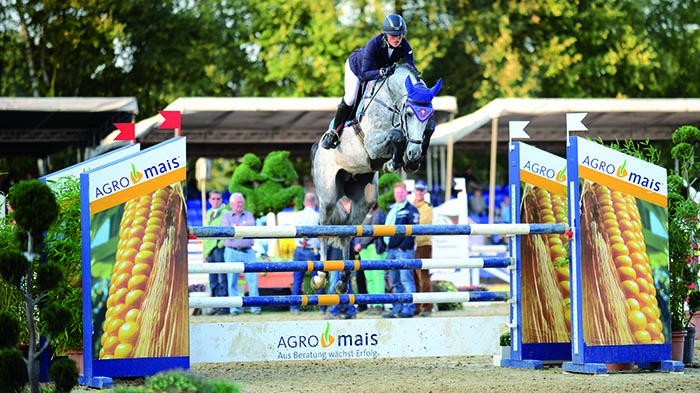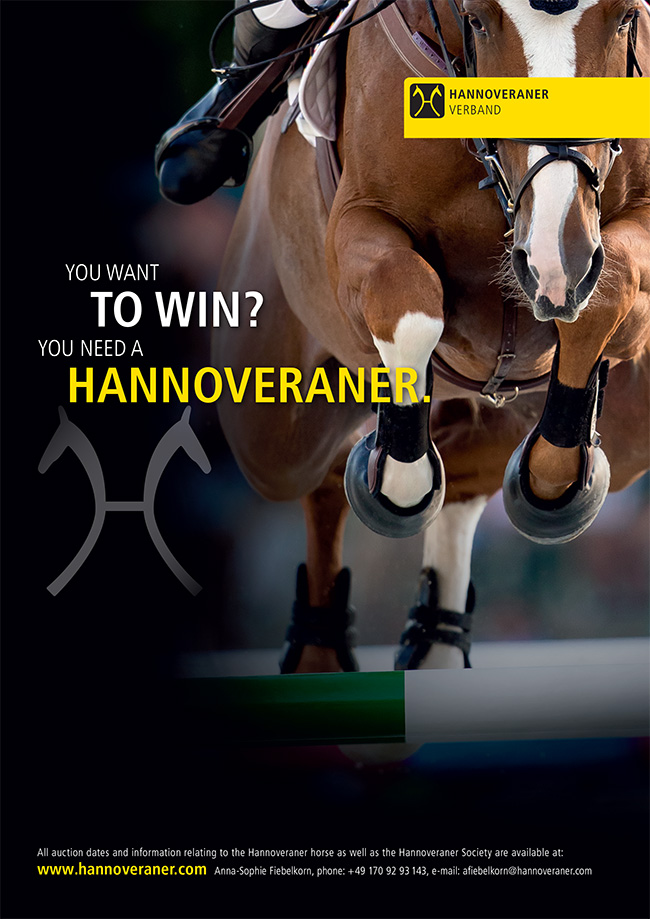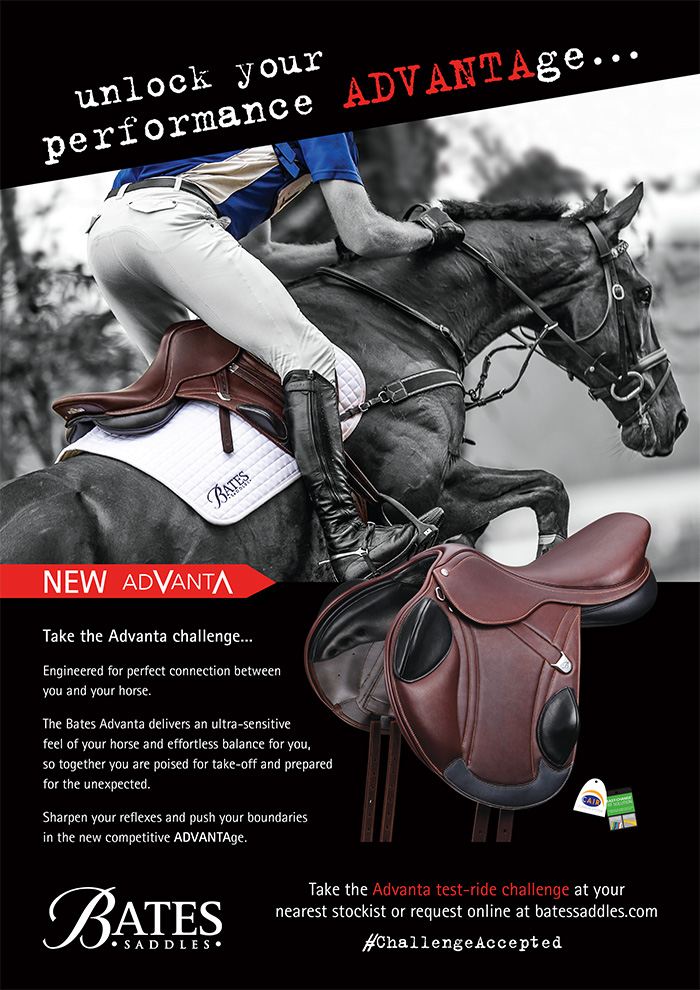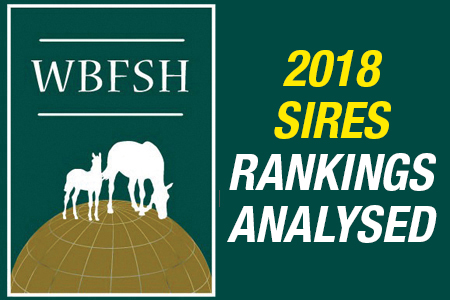
Gemma Alexander (Pacific Jumping Breeding ) and Christopher Hector analyse the World Breeding Federation for Sport Horses 2018 stallion rankings…
The 2018 WBFSH stallion rankings have finally appeared, and with them the perennial complaint that they do not take into account the number of mares covered in evaluating the success of the stallion. It is a pity that we do not have a universal disclosure of how many foals each stallion produced, each season, and over the lifetime of their career, so that we could meaningfully calculate the success rate as a percentage of the foals born across all the studbooks.
There are partial disclosures, and some studbooks are more upfront than others. For example, the KWPN, last month, released a very valuable analysis of their stallions. It showed that of the 552 licensed Dressage stallions with approximately 12,000 KWPN offspring competing at Z1-level or higher, the one with the highest success rate was – surprise, surprise – Jazz, with 666 offspring at Z1 or higher.
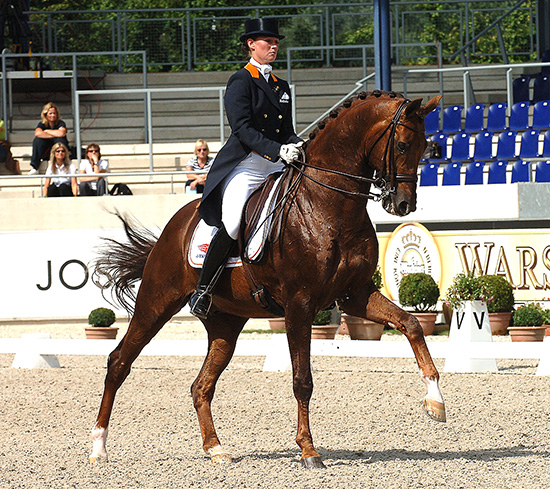
Jazz – still number one in Holland
The next most prolific was Gribaldi with 477, followed by Flemmingh with 378. The percentage that went on to Grand Prix would indicate that GP success is a tricky business, perhaps even in the realm where rider/trainer skill outweighs genetics? Jazz is recorded with 131 Grand Prix offspring, that is just 4.2%, and he is the most successful of them all – although it might be noted that of the 666 offspring that made it to Z1, 19.669% went on to Grand Prix. Contango despite only spending a couple of seasons in Holland before he was exported to the USA, and his semen did not freeze, so it was those first couple of seasons that counted, produced 24 GP horses at 3.8%.
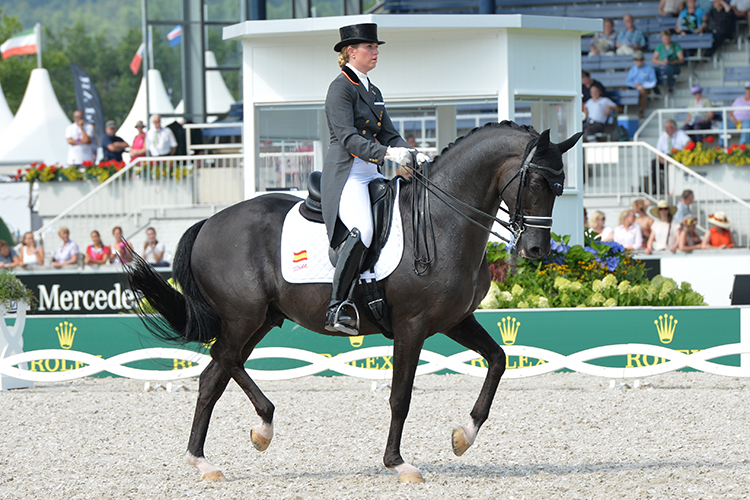
Painted Black – Grand Prix breeds Grand Prix
The list then goes: Painted Black (21 GP offspring, 3.6%), El Corona (10, 3.5%), Welt Hit II (21, 3.2%), Aktion (11, 2.9%) Gribaldi (82, 2.7%), Krack C (39, 2.5%), Cocktail (13, 2.5%) and Chronos (13, 2.5%).
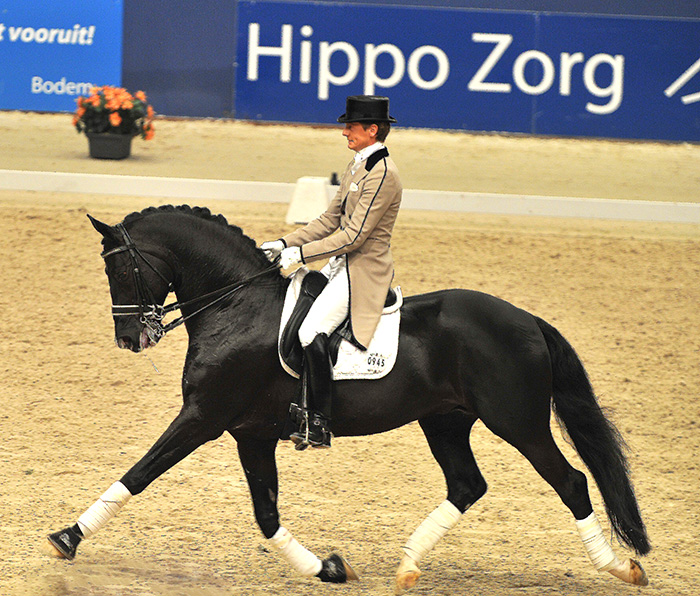
Gribaldi, second most prolific producer
However we can push a little further and then we come up with a somewhat startling result. If we consider the number of progeny and the number that reached Z1 level or higher, THE MOST successful stallion is Sir Sinclair (by Lord Sinclair out of a Flemmingh / Le Mexico mare) with 21.9% of his progeny ranking at Z1 or higher – though scrolling through the names of the 48 horses by Sir Sinclair that have made it onto the hippomundo database, I doubt there is one single name you would recognize.
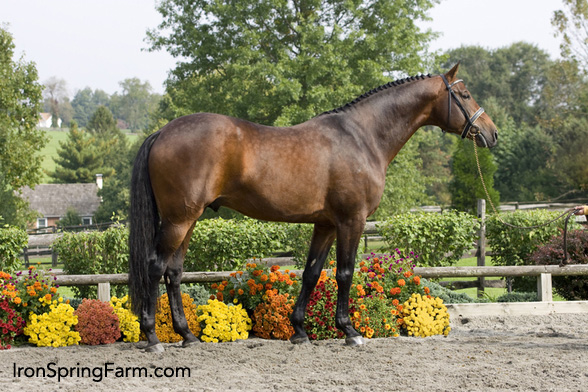
Sir Sinclair – most successful?
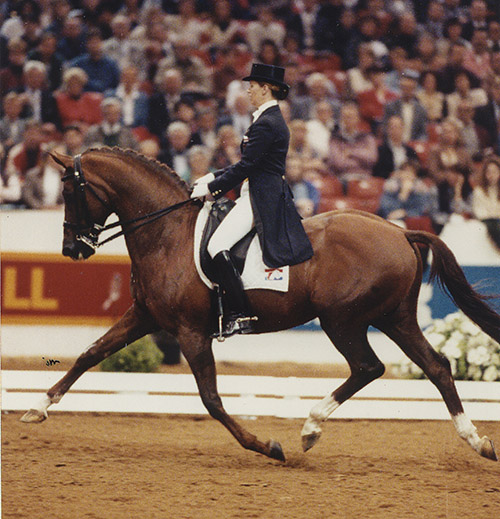
Cocktail competing with Anky van Grunsven, second best producer
The second best producer is Cocktail with 21.4%, followed by Jazz who is tied with Ziesto on 21.2%. Ziesto (Lancet / Clavecimbel) is described on several databases as a Grand Prix competitor, if that is the case, someone neglected to inform the official FEI database, which records a couple of Inter I wins with Hans Peter Minderhoud, as the highlights of the stallion’s international career. Still he produced 104 offspring in the Dutch book, with 22 of them at Z1 or higher.
El Corona is at 18.3%, Welt Hit II, 18.1%, Painted Black, 18%, Krack C, 17.5%, Olivi, 17.4% and Cabochon on 17.2%.
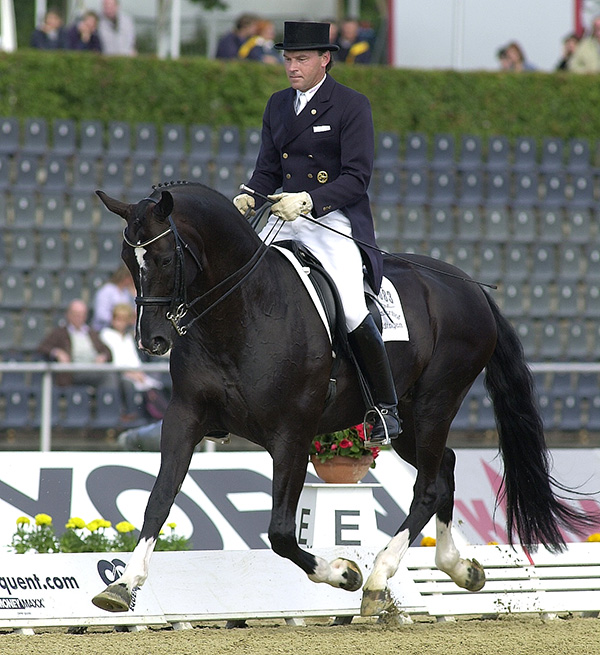
De Niro – the most successful in Germany
It is harder to get a handle on the percentages for the German horses because while the German FN obviously has the numbers, the various studbooks will not let the FN make the numbers public… We can get a good indicator by using the Hanoverian publication, Jahrbuch Hengste 2018. Thus is we look to De Niro‘s entry we find he has produced 1195 competitors (these are FN figures, so for horses from all the German studbooks, not just the Hanoverians) of which 220 have competed at S level, that’s 18.41%, and we might note in passing that as you glance through the 34 De Niro’s who have won €10,000 euros or more, you do recognize a galaxy of international stars.
For comparison, we can look at two much used stallions, Don Frederico, who was very popular, though perhaps not now that he has been revealed as a WFFS carrier, and Sandro Hit, probably the first stallion to cover mega-books of mares. Don Frederico is credited with 1047 competitors, with 129, or 12.32%, at S level, while Sandro Hit has produced 1227 competitors, 178 at S or better, and that’s 14.506%.
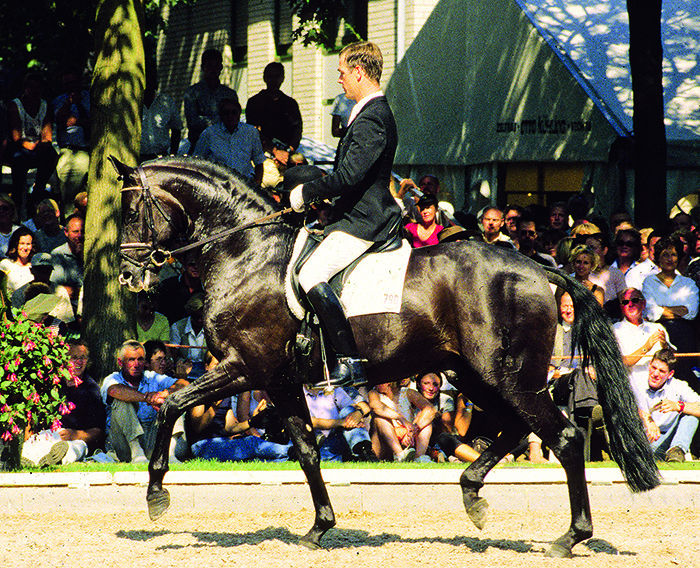
Sandro Hit, the first to cover mega-books of mares
Still it would be nice to have a meaningful world-wide comparison, using the same parameters to give us some clarity.
Next we discuss the showjumpers
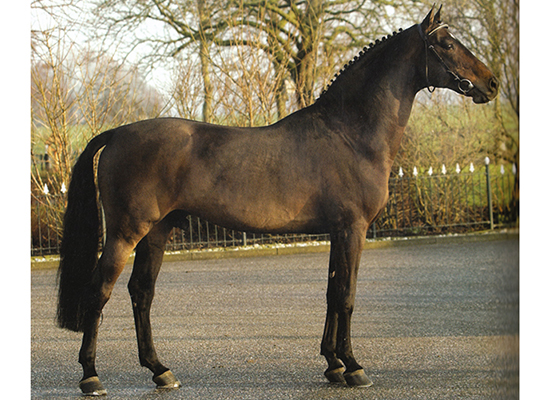
Indoctro – almost a thousand progeny jumped 1.30m!
What then of the Dutch jumpers? Now we are getting some largish numbers to play with. Over 19,000 horses registered with the KWPN have jumped 1.30m and higher and there are 508 KWPN stallions that have sired that group. The great Indoctro is well in the lead with 933 offspring, followed by Burggraaf with 614 and Numero Uno with 582.
As one would have expected, these stalwarts of Dutch breeding are there by longevity and sheer force of numbers. When we measure success against the number of progeny, a different picture emerges. Now the leader of the pack is Bacardi VDL since 36.4% of his offspring made it to 1.30m or higher, twelve of the thirty-three he has sired thus far.
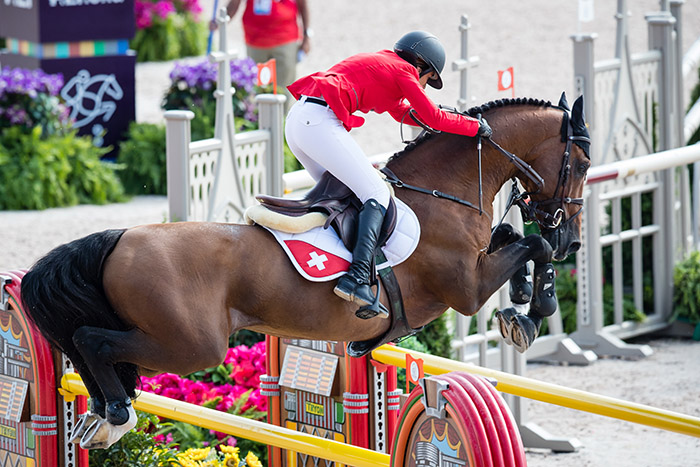
Bacardi and Janika Sprunger at the WEG in Tryon (Eric Knoll photo)
Bacardi is a son of ‘keur’ Grand Prix jumper Corland – Corland is by Cor de la Bryère out of a Landgraf mare. He was a respectable 1.60m jumper with Wout Jan van der Schans. Bacardi is out of a mare by Kannan. Bacardi himself has been a moderate performer at the highest level, good enough to make the Swiss team for Tryon with Janika Sprunger, but the best result I can find for the pair is a 5th in a five star at Valence in France. Still the bay stallion is bred to jump, not only is his dam by Kannan, but you can add to that the blood of jumping stallion Jasper (‘Little One’ with Hugo Simon), and then comes another Grand Prix jumper/sire, Fresco.
I guess we might worry about the small numbers involved in Bacardi’s result by way of an enormous contrast, the stallion with the second highest percentage of 1.30m jumpers to foals is Heartbreaker on 33.8% of the 984 foals he has produced, followed by Cantos with 30.2% of 827, Hors La Loi II with 29.9% (385), Mr Blue with 29.1% (533), Utopie with 27.9% (43), Padinus with 27.6% (493), Ukato with 26.9% (550).
But is the figure for Bacardi really ‘reliable’? So far two of Bacardi’s progeny have jumped at 1.45, most of his crop, at 1.35m. Heartbreaker is recorded with1420 progeny on the hippomundo base, with a staggering 105 competing at 1.60m.
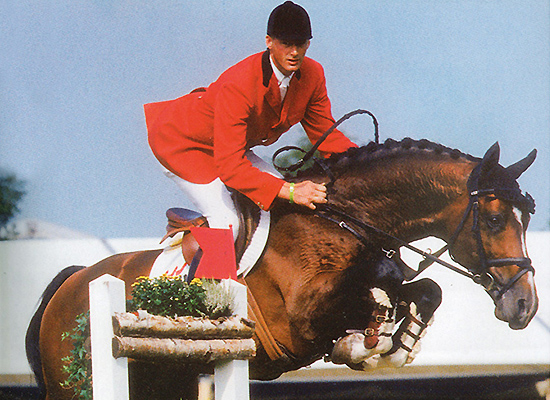
Heartbreaker, a staggering 105 competing at 1.60m.
Like they say there are lies, damn lies and statistics, but I know which stallion I would rather have cover my mare… Because a horse must be six years old before it can jump 1.30m, it is not surprising that we see ‘older’, proven stallions in this top 10 while the young sires have not had the opportunity to prove themselves. A horse that is now six, was born in 2012. Stallions approved in 2011 for KWPN breeding are the youngest stallions with offspring at 1.30m. These are Durrant (1), Dantos (1), Dutch Design (1), Dakar VDL (4) and World Cup winner Q.Breitling LS (11). Breitling is however two years older than his colleagues from the D-year and of these eleven offspring who are competed at 1.30m, six were born in 2012. The other five were born in 2010 or 2011.
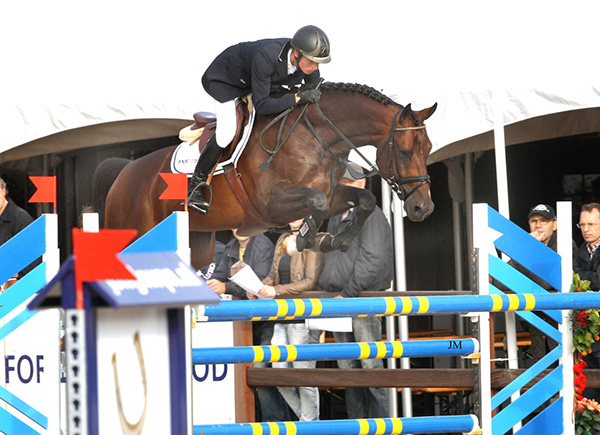
Q.Breitling, already producing jumpers…
The C-year is a year older: Carrera (1), Cédric (2), Charisma (4) and Crespo VDL (8). In 2010, the stallions Eldorado van de Zeshoek, Falaise de Muze, Saffier and Spartacus also received the approval for KWPN breeding. However, these stallions are slightly older and therefore have more offspring at 1.30m level: Sapphire has four, followed by Falaise de Muze with six, Spartacus with 68 and Eldorado van de Zeshoek with 120.
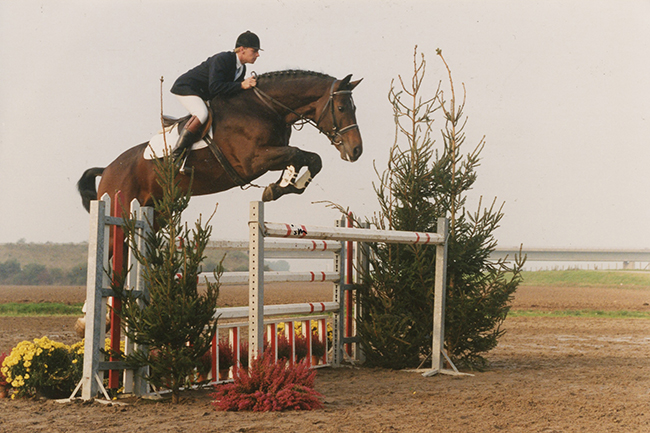
Burggraaf – still number one (Photo – Jacob Melissen)
The results at Grand Prix level present no surprises. Burggraaf takes the lead with 101 Grand Prix offspring, followed by Indoctro with 100 and Concorde with 91 in third place. If we measure the number of Grand Prix offspring against the number of KWPN-registered foals, Libero H takes the lead with 7.6%, he has produced 44 KWPN-registered Grand Prix horses. Followed by Heartbreaker (62 GP-horses, 6.3%), Silvio II (14 GP-horses, 4.7%), Animo (43 GP-horses, 4.7%), Celano (30 GP-horses, 4.5%), Andiamo (27 GP horses, 4.4%), Hors La Loi II (17 GP-horses, 4.4%), Lux (41 GP-horses, 3.5%), Guidam (36 GP-horses, 3.5%) and Calvados (54 GP horses, 3.4%).
next the eventers
WBFSH Rankings Eventing
Looking at the final top 15 eventers at the Tryon WEG, six are French bred, three Irish, two KWPN and two from Germany. This is not an entirely unexpected result. Since 2004, the Irish have headed the studbook standings twelve times, while the fortunes of the French have fluctuated, second (to the Irish) five times, once in first, but twice sixth and once dropping as low as seventh.
There are three changes to the top 10 WBFSH 2018 standings: Puissance (Imperius xx – Lady Marlane x Diamonds are Trumps), Lux (Lord Calando – Apocolypte Z x Ahorn Z) and Cruising (Sea Crest – Mullacrew x Nordlys xx) are out, while Courage II (Capitol I – Vamara x Cor de la Bryere), L’Arc de Triomphe (Landor S – Praeludium x Pilot) and Contender (Calypso II – Gofine x Ramiro) are in. The jumping stalwart Contender not only comes in at number 10, but is also sire of the top-ranked Contendro I (Contender – Bravo x Reichsgraf).
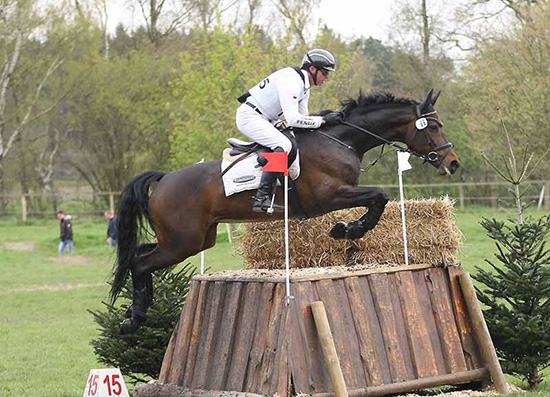
FRH Corrida – winning points for Contendro
This year Contendro I heads the Eventing Sires rankings, for the fourth year in a row (two more and he will equal the great Heraldik who stood at the top of the standings six times). His success is based largely on two four-star German eventers, both Hanoverians, Andreas Dibowski’s mare, FRH Corrida (Espri) and Julia Krajewski’s gelding, Chipmunk FRH (Heraldik!!!), who has had two three-star CIC wins this year, at Aachen and Bramham. They are ranked 23rd and 34th in the world respectively, the next most successful are Candy Girl (Carolus) at 124 and Chatwin (Oldtimer xx) at 145 – after that there’s one at 397, and the rest are all ranked lower than 500, most lower that 1000.
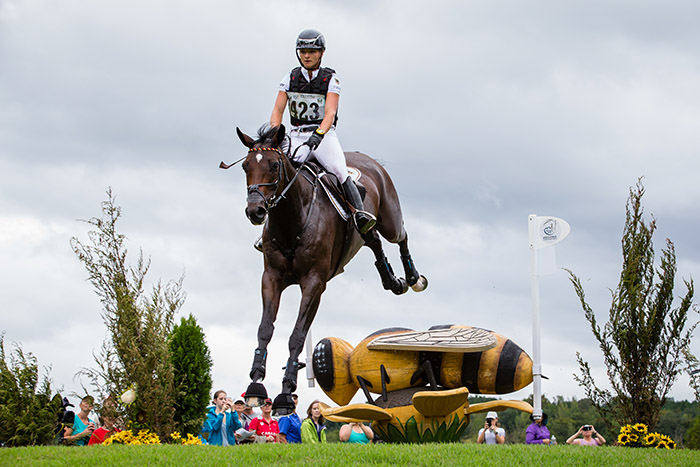
More points – Chipmunk
So Contendro nicked with a couple of mares in Lower Saxony, since then he has moved to the GFC stable in Normandy, and it will be interesting to see if he works with the Selle Français and Anglo Arab mares he encounters.
Contendro I was primarily bred as a showjumping sire. When he won his stallion performance test at Adelheidsdorf, he topped the jumping test but finished a very respectable 4th in the dressage standings. Still he has only bred three dressage competitors with winnings of more than €10,000 while he is the sire of 34 showjumpers who have earned more than €15,000, headed up by Codex One with €1,410,505! At the same time he has produced four eventers with earnings over €5,000.
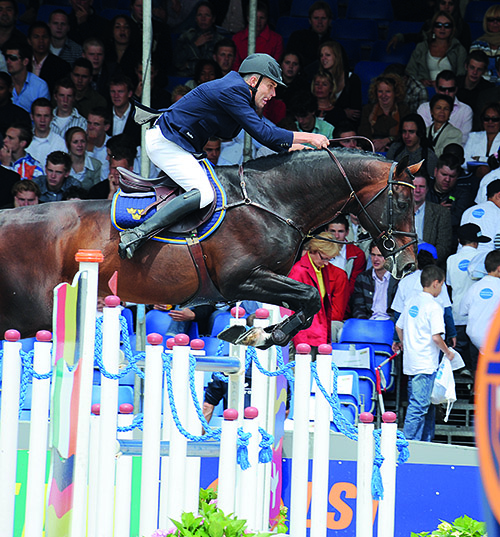
Jaguar Mail – showjumper, eventing sire…
I guess when Bernard le Courtois bred Jaguar Mail (Hand in Glove xx / Laudanum xx, that’s 3/4 Thoroughbred, with the remaining quarter divided between Almé and Gotthard) he had the showjumping arena in his sights, and sure enough Jaguar Mail took Peter Eriksson to the Beijing Games in the Swedish Showjumping team, however it has been as a sire of eventers that Jaguar Mail has earned his keep.
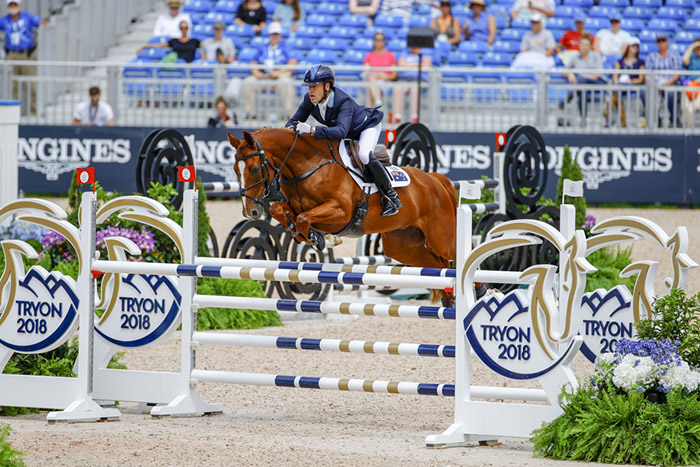
Vassily – Jaguar’s number one
The shooting star at the WEG in Tryon was Andrew Hoy’s Vassily de Lassos, the gelding he bought from French Eventer, Thomas Carlile. Thomas has had considerable success with the Jaguar Mail / Anglo Arab cross, riding Tenareze (Quatar de Plape aa) to 6 and 7 year old World Championships. Thomas told me at the time that he thought the Jaguars could be a bit loose in front, and he liked a jumping Anglo Arab dam to tighten them up – and sure enough Vassily is out of a mare by Jalienny aa. Currently Vassily is ranked 10th in the world. The next most successful is Jum Jum (57th) out of a mare by the Thoroughbred, Papi’s Boy followed by another product of Bernard’s breeding, Tresor Mail (74th) who is out of a mare by the Dutch stallion, Iowa.
It is interesting that where a stallion stands can so dramatically affect their success rate. Bernard le Courtois has written that if Cor de la Bryère had stayed in France he would have not been a significant stallion (he would have ‘bred rabbits’ I think his assessment was), he needed the big Holsteiner mares to work with. The reverse is also true, there are a handful of Holsteiners who moved to Ireland where on the rich soil of the heavily Thoroughbred influenced Irish mares, they flourished. Had they remained on the marshes of Holstein, they may well have ended up feeding some honest hound… Courage, sometimes known as Courage II, is a case in point.
He is certainly well enough bred, by Capitol out of Vamara (Cor de la Bryère / Liguster) who was also the full-sister of sometime world number one eventing sire, Cavalier Royale – whose success also came thanks to his Irish mares. Courage arrived in Ireland in 2002 as a 12-year-old (seemingly from Switzerland, and without the Holstein stallion seal of approval), and in just a couple of seasons sired a goodly number of eventers while standing at Thomas Meagher’s Kedrah stud.
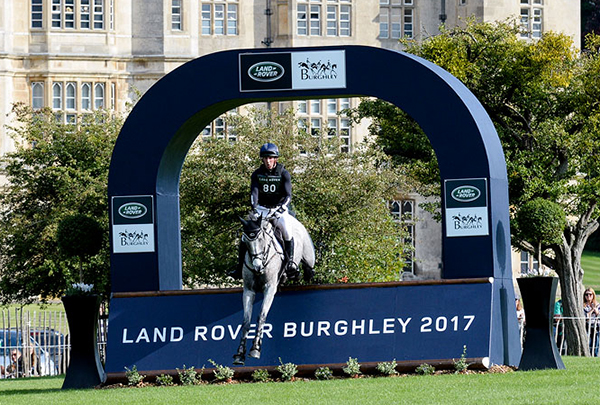
Ballaghmore Class – representing Courage
Courage’s highest points earner is Ballaghmore Class (the mare is by that former mainstay of Irish breeding, ‘unknown’), a star with Oliver Townend, including a first at Burghley 4* in 2017. They are ranked 17th on the current standings. His next highest ranked are Ringwood Sky Boy (Sky Boy xx) 26th and Camebert (Colin Diamond) 29th.
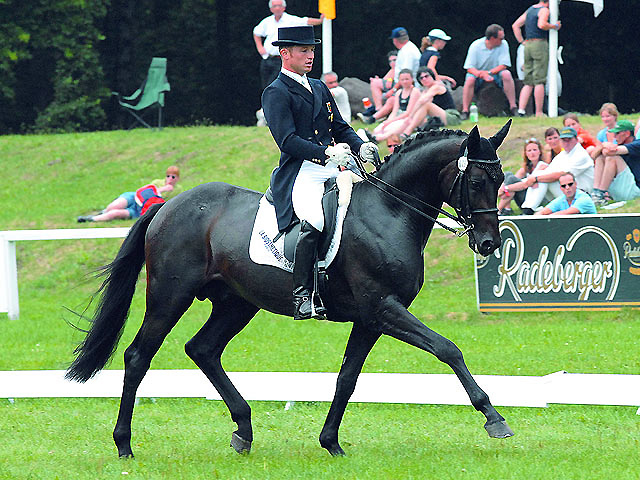
Michael Jung and Grafenstolz
Grafenstolz, in fourth place, is perhaps the first stallion on our list who was bred with eventing in mind, although the stallion achieved the rare distinction of qualifying for the Bundeschampionate in eventing and dressage and showjumping, actually winning the eventing class with one Michael Jung on board. Jung also won the World Six-Year-old Eventing title with Grafenstolz that year, and while the pair went on to compete three-star, the Trakehner stallion didn’t really make the grade – although we might remember what Andrew Nicholson said of Jumbo, the eventing stallion he rode – and who features as 11th on these rankings, stallions “are not really made to be cross country horses, especially the older they get – they get very protective of themselves. A lot of people criticize some stallions as they get a little older, thinking they are not brave enough to be eventers, but really it is just their nature taking over. They are not meant to be going places they haven’t been before, that’s their nature.”
Grafenstolz most successful eventers are Guccimo R (Exquis Carnando) 360th in the world, and Grand Prix I West (Grafenstein) 361st.
I’m quite certain Paul Schockemöhle didn’t go out looking for an eventing sire when he bred the fifth ranked Balou du Rouet (Baloubet du Rouet / Continue), and indeed there is nothing much in the stallion’s pedigree that would suggest eventing. For a start he has only 31.85% ‘blood’, and he has negative FN breeding values for dressage, (96 for young horse competition, and 92 for open competition). The Hanoverian values are even less encouraging – he is given an overall dressage value of 73, and is negative in all three gaits and rideability: 67 trot, 82 canter, 75 walk and 81 for rideability. His Hanoverian jumping value is 147, his FN jumping value for young horse classes is 142, in open competition, 127.
He is the sire of 23 horses that have won more than €15,000 in the showjumping arena. The Hanoverian Stallion book doesn’t even mention eventers – yet there he is, fifth on this year’s rankings! This is largely due to two horses, Reve de Rouet and Billy the Red, who between them contribute 439 points to the stallion’s total, his other nine representatives muster a mere 236 all up. Reve du Rouet (14th in the world) is out of a mare by the Jalisco son, Oscar de Revel, out of a Contender mare. Sarah Bullimore rode the gelding to second at Pau 4* last year, fourth at Burghley 4*, this year. Billy the Red (32nd), is out of a mare by Stan the Man xx, sire of Biosthetic Sam, and was Kristina Cook’s ride at the latest WEG where they finished ninth. They won team gold, and placed an individual fourth, at last year’s Europeans.
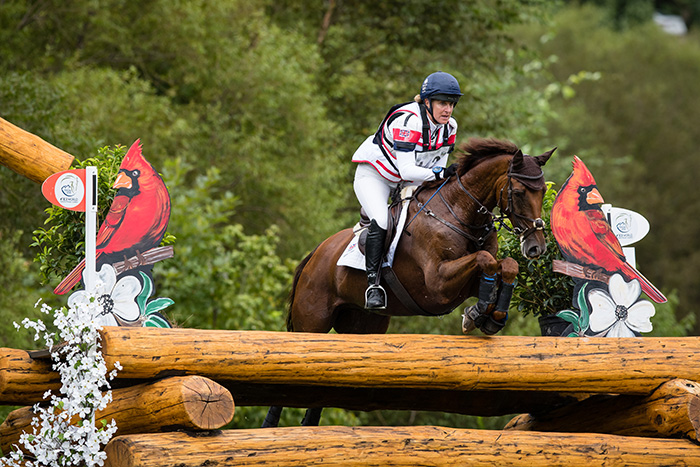
Billy the Red at Tryon (Eric Knoll photo)
The Irish didn’t only get their new blood from Holstein, there were two Belgian horses that left their mark, Ramiro B and Don Juan de la Bouverie. Don Juan doesn’t make the top 100 this year, but Ramiro B is right up there in sixth thanks to horses with the Cooley prefix – as we’ve pointed out previously, this is not a stud prefix, but a marketing brand put together by the clever duo who run Cooley Farm, Georgina Phillips and Richard Shearne. They don’t breed horses, they scour Ireland looking for eventing prospects, polish them a bit and sell to a who’s who of world eventing. And they like Ramiro B, indeed Georgina told us, he was her favorite stallion.
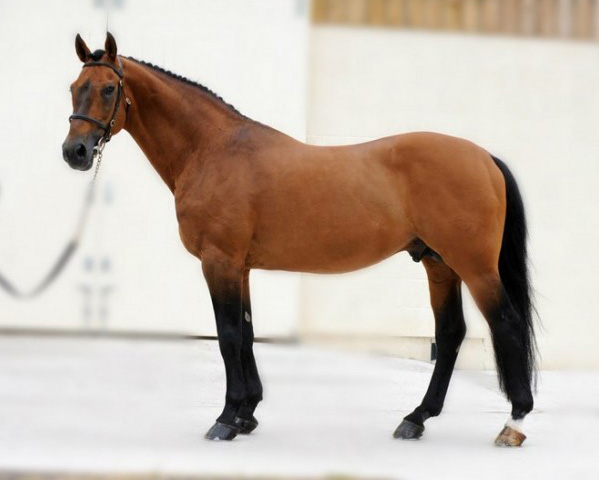
Ramiro B – the Belgian stallion siring top eventers
You might be forgiven for thinking Ramiro B had something to do with Ramiro, the Holsteiner who stood at Zangersheide, but he is not. Ramiro B is by the Caretino son, Calvani, out of a mare by Wendekreis. Ramiro B was imported to Ireland as a youngster, and ridden at Grand Prix showjumping level by Edward Doyle.
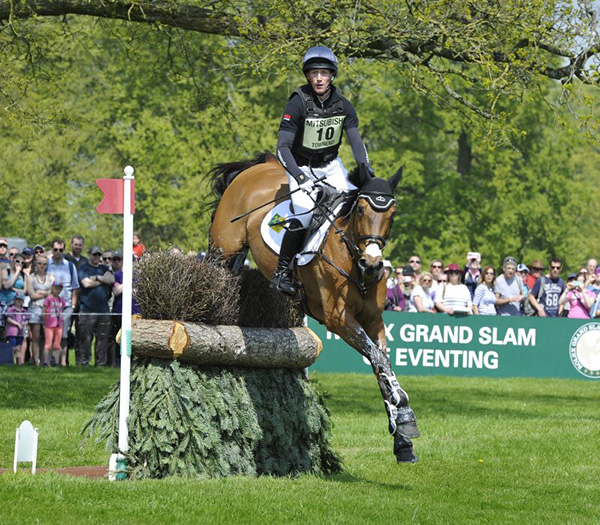
Cooley SRS, a star with Oliver Townend
Ramiro B is the sire of Cooley SRS (Kitealy Spring / King of Diamonds), 42nd in the world and second this year at Badminton with Oliver Townend. Then there is Cooley Ramiro (out of a Cavalier Royale / Clover Hill mare), 112th in the world rankings. Cooley Monsoon, out of a Krakatan (who IS by Ramiro) mare, 129th and Cooley Master Class (out of a Master Imp / Cavalier Royale mare) first at Lexington this year, ridden by… yep, Oliver Townend. Master Class ranks 137 this year.

Hamilton and Josefa Sommer
Seventh to that stalwart of eventing breeding, Heraldik xx, still supplying top quality eventers, thirteen years after his death. His highest ranked this year is Hamilton (Furioso’s Sohn) in 99th.
It seems odd to find L’Arc de Triomphe in 8th. For all his very French name, he is a German, by Landor S out of a Pilot mare. A star at the Fences Auction, he soon became quite controversial, let Bernard le Ccourtois tell the story in his inimitable style: “This is a horse that I know well, having selected him with my Fences associates at the age of three, when his loose jumping naturally impressed me… Then for having followed him as a 4-year old in Bruno Souloumiac’s stables and then finally two years later during an unsuccessful competing period of a few months with Patrice Delaveau and the help of a ‘whisperer’… This over-gifted horse has a more than borderline temperament and has never taken kindly to competing. This was to be expected, as his breeding by Landor S, as well as Pilot, is reputed to produce quality horses, but of a difficult temperament… Neither force nor whisperers were to reason with him. This horse, probably far more intelligent than his counterparts, has always done what he wished. Whether in hand, ridden or serving. He once again gave proof of this at the stallion show in Poitiers in February 2008, when he refused to enter the ring to be presented to the public. And his sporting career was effectively very short and delicate, he in fact only really jumped as a 5-year-old.”
For all that, L’Arc covered hundreds of mares, producing seven 1.60m showjumpers, and thanks to one horse, the mare, Romantic Love (out of a Thoroughbred mare by Shercame xx) who carried France’s Gwendolen Fer to first place at the 2017 Pau 4* (and 37th in the world), he makes the eventing sires top ten. The next best of his get is in 209th then it is out in the 2, 3, 4 and 5 thousands. Which I guess proves that it still doesn’t take much to top ten in eventing, especially when you look at what it takes to top the jumping standings.
The final two placings go to two of the historic greats: Master Imp and Contender.
It is no surprise at all that the eventing sires have the highest blood percentage, with the top 10 averaging 55.94%.
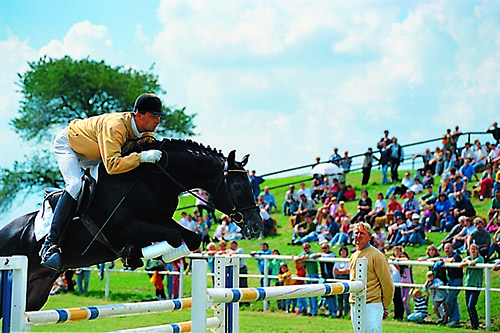
Heraldik and Thomas Casper in action
Two stallion in the top 10 are full Thoroughbred, Heraldik xx (Caramel – Heraldika x Cale) and Master Imp xx (Imperius – Tranquilla x Hul a Hul). Of the top 10 eventing sires, the furthest back in the pedigrees for Thoroughbred to appear for the first time is the 4th generation. The stallion with the smallest blood percentage in the top 10 is the thoroughly jumping-bred L’Arc de Triomphe.
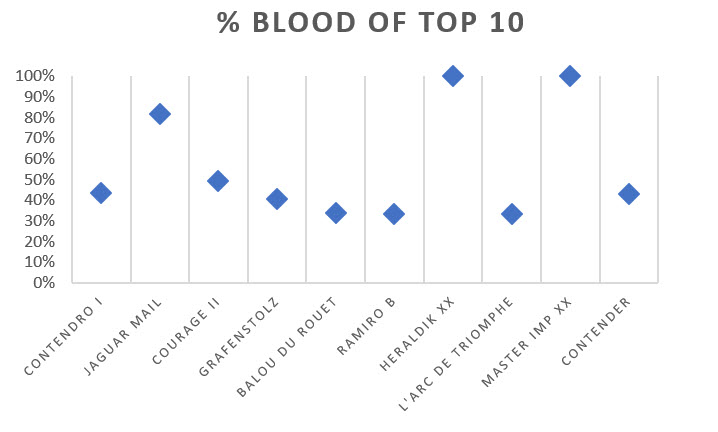
As with the dressage sires and the jumpers, all of the top 10 eventing sires have some degree of line-breeding evident in the first six generations. The closest incidence of line-breeding in the lineup is in generation three, while 70% see the first line-breeding in the 4th generation, and 20% in the 5th generation. The eventing sire with the greatest degree of line-breeding in the rankings is Contendro I: Ramiro (Raimond – Valine x Cottage Son xx) appears 3x4x4, on both the top and bottom of the pedigree and sex-balanced; the Anglo Arab Ramzes X (Rittersporn xx – Jordi x Shagya X-3) appears 5x5x5x6x6, top and bottom and sex balanced; and the Thoroughbred Ladykiller xx (Sailing Light – Lone Beech x Loaningdale) is found 4×5, top and bottom, and sex-balanced.
Despite the incidence of purpose-breeding for eventing being on the rise, when looking at the strike rate (as with the others, based off the Horsetelex database), it becomes evident that there is a little less science and a little more luck than is seen in the other Olympic disciplines. The top five eventing sires based on strike-rate of offspring making it to 4* level are: 1. Ramiro B (Calvani – Lilly x Wendekreis) (8.47%) 2. Master Imp xx (4.67%) 3. Courage II (4.35%) 4. Heraldik xx (2.33%) 5. Jaguar Mail (Hand in Glove xx – Elvira Mail x Laudanum xx) (0.42%).
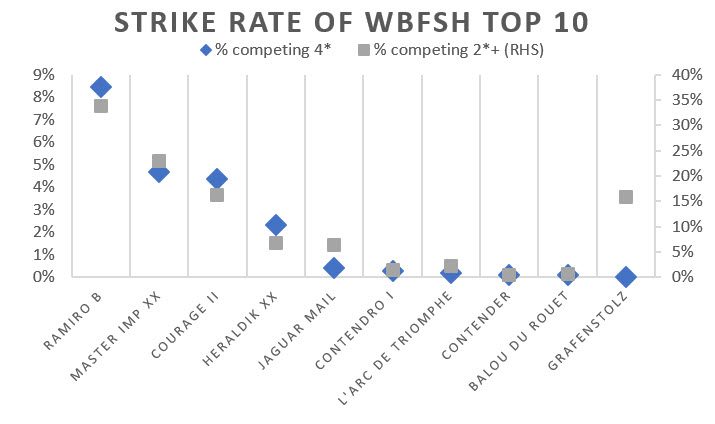
Ramiro B also leads the pack for the strike rate of offspring that have made it to 2* level and above, at 33.90%, followed by Master Imp xx at 22.90% and Courage II at 16.30%. Interestingly, WBFSH-4th-ranked Grafenstolz (Polarion – Gipsy Lady x Camelot) has no offspring in the Horsetelex database as having reached the 4* level, however he does have a relatively strong strike rate of 15.85% of offspring competing at at least the 2* level. Could this be due to gaps in the Horsetelex database? Possibly.
next the dressage ratings
Want to the best stallion for your mare? You can, right here in Australia. Go to www.ihb.com.au
Want to try the latest new young stallion? A producer who has proved himself? There’s a selection for you to choose from.
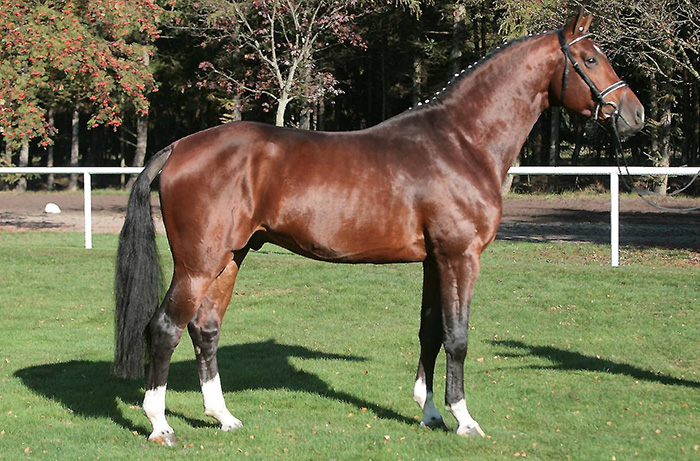
WBFSH Rankings – Dressage Who’s In – Who’s Out?
There have been four changes to the top 10 in 2018: out are Gribaldi (Kostolany – Gondola II x Ibikus), Sir Donnerhall I (Sandro Hit – Contenance D x Donnerhall), Florestan I (Fidelio – Raute x Rheingold) and Don Schufro (Donnerhall – Fiesta x Pik Bube I); in are Johnson (Jazz – Roxane x Flemmingh), San Remo (Sandro Hit – Donja Anjana x Donnerhall), Diamond Hit (Don Schufro – Loretta x Ramino) and Dimaggio (Don Primero – Winnipeg x World Cup I).
Sandro Hit (Sandro Song – Loretta x Ramino) is a stand-out, not only coming in 2nd in the rankings, but also being joined in the top 10 by two sons, San Remo and Stedinger (Sandro Hit – Bold Fantasy x Landadel).
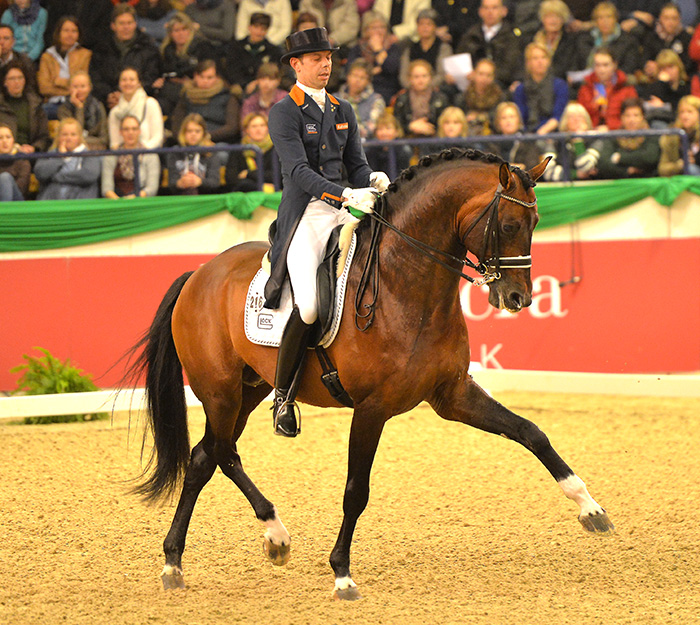
Johnson joins his sire in the top ten…
Jazz (Cocktail – Charmante x Ulster) in 4th position is also joined by his son Johnson, ranked 6th.
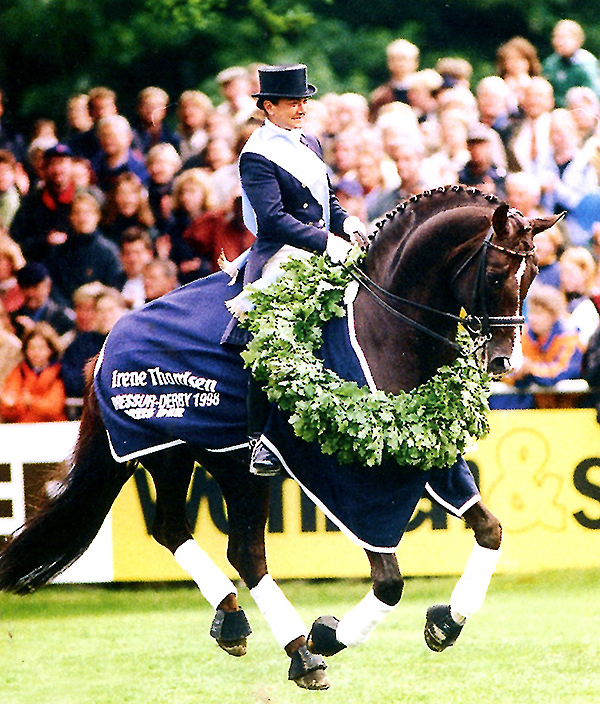
Donnerhall, still the greatest influence
Donnerhall (Donnerwetter – Ninette x Markus) is the stallion with the greatest influence on the top 10, with two sons, De Niro (Donnerhall – Alicante x Akzent II) and Don Frederico (Donnerhall – Cleopatra x Consul), and one grandson in San Remo.
There’s not a lot more we can say about De Niro. He was Number 1 Dressage sire in 2012, and has held the spot every year since then, save 2014 when he slipped behind Gribaldi. To celebrate yet another win, his son, Delgado, took out the Madrid Grand Prix in the same week the standings were announced.
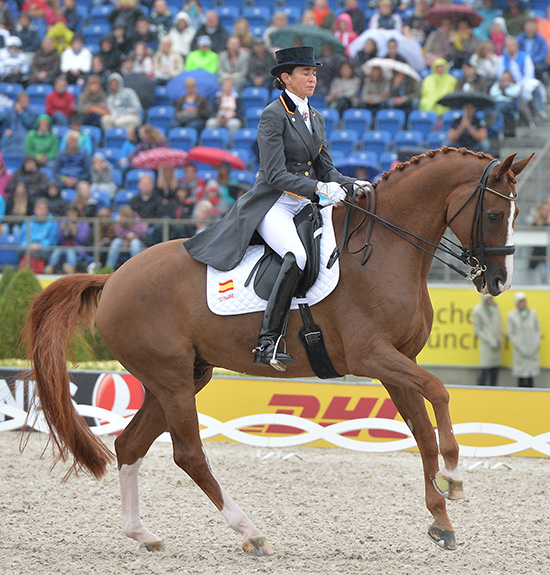
Delgado – leading for De Niro on the standings
It is interesting that Burkhardt Wahler who ‘found’ De Niro at the Hanoverian licensing, came from a Trakehner background, and was prepared to swim against the tide in making his selection: “I love to buy the Donnerhall blood but I don’t like the very popular Donnerhall / Pik Bube cross – very heavy big horses, and I didn’t like that so much because I am from the other side, from the Trakehner side and I like more an elegant horse. I really liked De Niro, because he was out of a mare with Wiesenbaum / Akzent breeding. Akzent is through Absatz, Trakehner, Wiesenbaum is from Thoroughbred – so in my opinion, this was a very interesting bloodline.”
De Niro has put seven horses into the dressage top 100: Delgado (Weltmeyer) 19th, Deep Impact (Rubinstein) 26th, Delatio (Rubinstein) 31, D’Agostino (Shogun xx) 32nd, Danilo (Andiamo) 33rd, Du Soleil (Caprimond) 44th and Degas 12 (Regazzoni) 79.
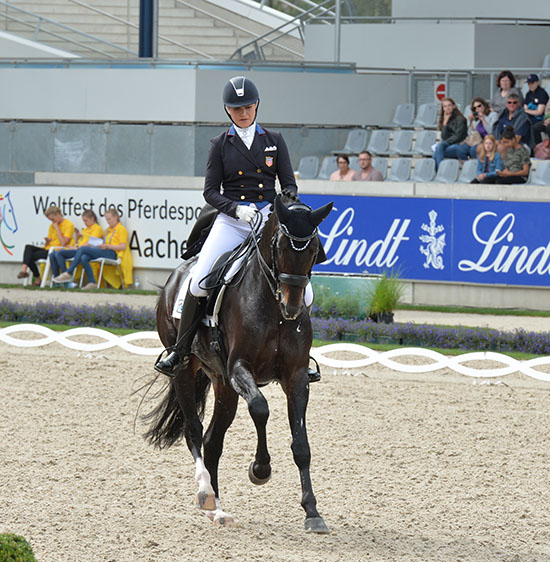
Adrienne Lyle and Salvino – top points for Sandro Hit
In second place we have Sandro Hit. I confess that I never thought he would be a producer of Grand Prix progeny, but there they are. Adrienne Lyle has won a 5* Grand Prix in Wellington on Salvino (Donnerhall) to take him to 20th on the rankings, then there’s Sir Donnerhall (Donnerhall), 52nd, and Selton HW (Hohenstein) in 59th.
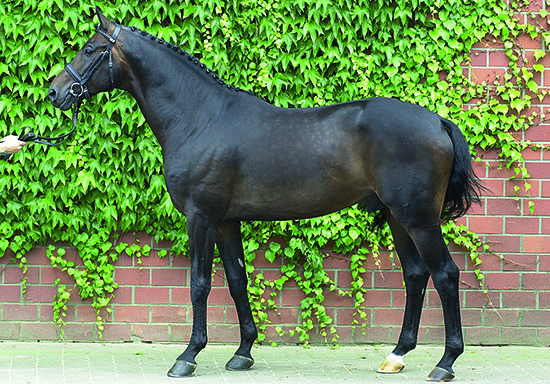
Rubin-Royal – tops for the R line
Fourth ranked dressage stallion is Rubin-Royal, who seems to have single handedly rescued the R line of Rubinstein. The general complaint against the Rubinsteins, aside from their tendency to wind suck, was that they were cutesy things that lacked power or impulsion. Rubin Royal may have escaped this curse, since his dam is out of the extremely athletic mare band of Harli Seifert, who started with an eventing mare, Chico, and bred her to the half blood, international eventer, Volturno to produce the progenitors of her two lines. Rubin Royal is out of Harli’s ‘dressage’ line, but there’s plenty of jump there as well – Grande and Gotthard, and plenty of Trakehner, Semper Idem and Absatz.
Rubin Royal is by the Rubinstein son Rohdiament, so there is a dash of French Anglo Arab from Inschallah, over a mare who paid her way working in the fields…
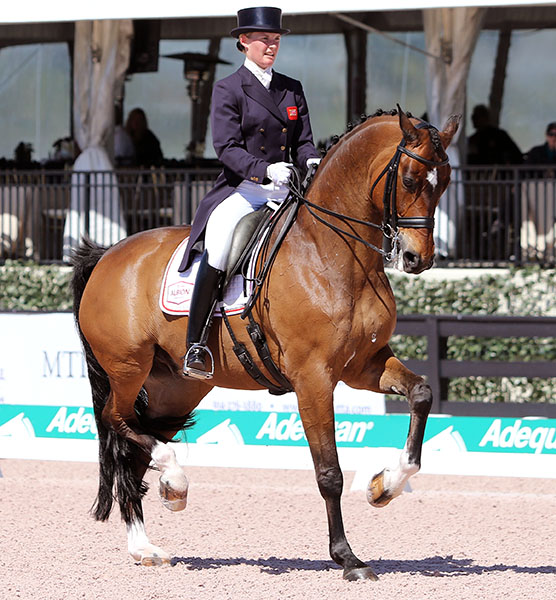
Rubin Al Asad and Lara Butler (Photo Kenneth Braddick, dressagenews)
Rubin Royal’s highest points scorer is Rubin Al Asad, ridden by Britain’s Lara Butler, the highlight of their career thus far, victory in the GP Special at Rotterdam last June. Again the Hanoverian gelding has power on his dam line – the Hanoverian, Wanderbursch II, better known as a sire of jumpers, and the Thoroughbred, Lemon Tree. They are ranked 36th, and there are two more in the 100, Rubins Nite (Limbo) 42nd and Real Dancer FRH (De Niro) 49th.
Jazz continues to influence the sport although he is slowly slipping down the rankings. His front liner is Adelinde Cornellissen’s Zephyr (Farmer) who recently won the 3* GP and Freestyle at Exloo. The pair rank 71st in the world.
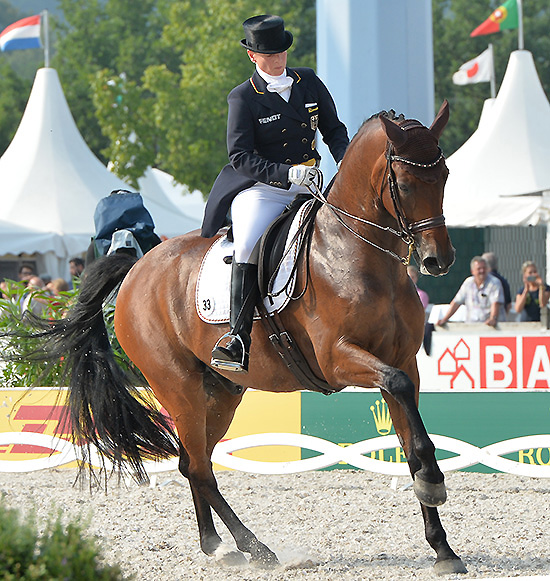
Don Johnson, tops for Don Frederico
There is another Donnerhall in the top ten, Don Frederico (Consul) in fifth. His top is Isabell Werth’s Don Johnson (Warkant) ranked 11th in the world.
Jazz’s influence lives through his son, Johnson whose top-liner is Ben Johnson (Ferro) who took out 3rd in the GP and Freestyle at Cappln 4*, ridden by Marlies van Baalen, and bred by distinguished Breeding News correspondent, Claartje van Andel. The pair rank 132nd in the world.
It is interesting the number of horses that seriously competed Grand Prix in the top ten: De Niro, Rubin Royal, Jazz, Johnson, Diamond Hit, and just outside the ten, in 11th, Gribaldi, and Rubin-Royal’s full brother, Romanov (14th).
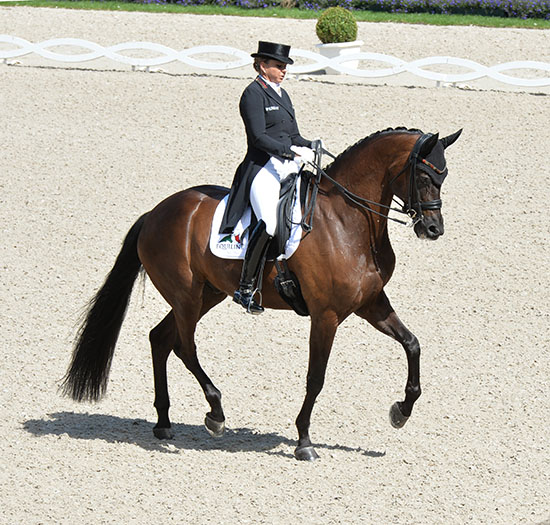
Sammy Davis Jr – by the Sandro Hit son, San Remo
Seventh place, the Sandro Hit son, San Remo (Donnerhall!), his best product is Dorothee Schneider’s team gold medalist at Tryon, Sammy Davis Jr (Wenckstern), who is ranked 7th in the world.
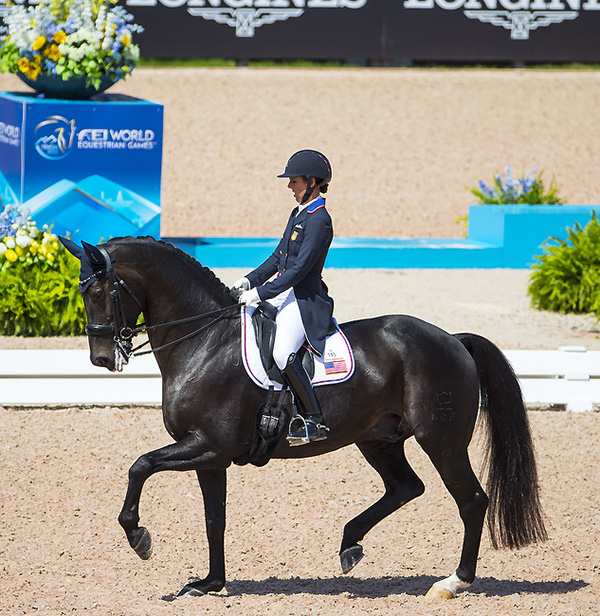
Kasey Perry Glass and Goerkintgaards Dublet
Then we are back on the D line gravy train: eighth to Sandro Hit’s half brother, Diamond Hit, by Don Schufro out of the redoutable Loretta by Ramino. His best product is Kasey Perry Glass’s Goerkintgaards Dublet (Ferro), 6th at Tryon, 2nd at Aachen 5*, 14th in the world, followed at 23rd place by Carl Hester’s new star, Hawtins Delicato (Regazzoni).
Ninth to Dimaggio (Don Primero / World Cup I), the sire of Headmore Delegate (mare by the Akzent II son, Akut), a successful under 25 competitor with Rebecca Jane Edwards, and in 73rd place. Tenth to Stedinger (Landadel), a young horse winner and the sire of world 82nd, Fil Rouge (Argentinus), 29th in the Grand Prix at the Tryon WEG with Belgium’s Laurence Roos.
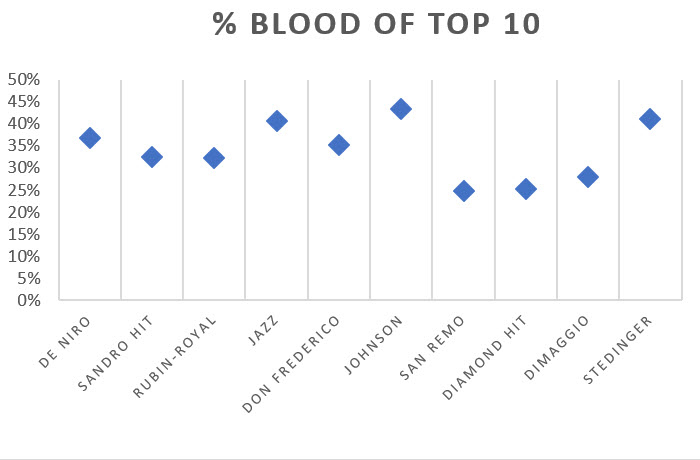
As would be expected, the average level of ‘blood’ for the dressage sires is considerably lower than for the jumpers, at 34.04%. No Thoroughbred appears in these stallions’ pedigrees earlier than generation three; 40% have Thoroughbred first appear in the pedigree in the 3rd generation, 50% in the 4th generation and 10% in the 5th generation. The top-10 stallion with the highest blood percentage is Johnson at 43.36%, even though a Thoroughbred ancestor is not seen in his lineage until generation four. The stallion with the lowest blood percentage in the top 10 is San Remo, at 24.80%.
Similar to the jumping sires, all of the dressage top 10 sires have a degree of line-breeding within their first six generations; in fact all of these stallions had line-breeding first appear in the pedigree in generations four or five. Of these top 10, 60% had the first incidence of line-breeding in the 4th generation, and 40% in the 5th. The stallion in the top 10 with the greatest degree of line-breeding is De Niro: Ferdinand (Ferrara – Herzenskind x Helgoland I) appears 4×5, on the bottom of the pedigree only, and only through daughters.
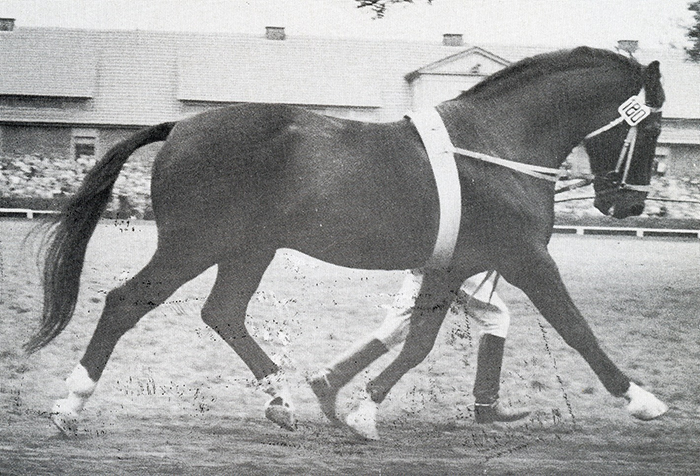
De Niro, line bred to Ferdinand, and
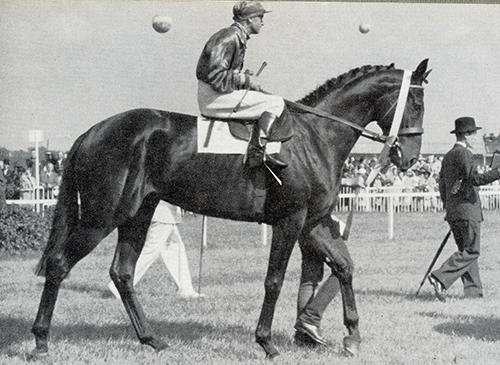
Neckar… now that’s something of a contrast
The Thoroughbred, Neckar xx (Ticino – Nixe x Arjaman) appears 5×5, dam side only, sex balanced, while the TB mare Waldrun xx (Alchimist – Walburga x Aurelius) appears 5×6, dam side only and is sex-balanced through both a daughter and son representative.
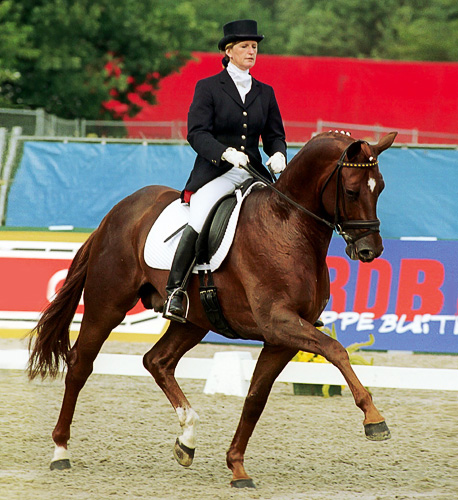
Dimaggio – top strike rate
And the strike rate of offspring who have reached Grand Prix level, based on offspring and their performances listed in the Horsetelex database? Such a top five would read: 1. Dimaggio (6.05%) 2. Rubin-Royal (Rohdiamant – Rumirell x Grundstein II) (4.94%) 3. San Remo (4.73%) 4. Diamond Hit (4.30%) 5. Sandro Hit (3.90%). Dimaggio also had the highest strike rate of offspring who have reached at least Prix St George level at 15.61%, followed by San Remo with 14.79% and Rubin-Royal at 11.59%.
WBFSH Showjumping Sires.
It is no surprise to find Chacco-Blue at the head of the Showjumping rankings, the stallion has gone from strength to strength as a sire, and the latest Hanoverian stallion book credits him with progeny earnings of €3,047,633 from his 1021 competitors in Germany alone. His current flag-bearer is Ben Maher’s Explosion W (Baloubet du Rouet) who in the last two months has cleaned up two GCT 5* 1.60 Grand Prix, in Doha and Rome, to take the gelding’s earnings to €771,672.
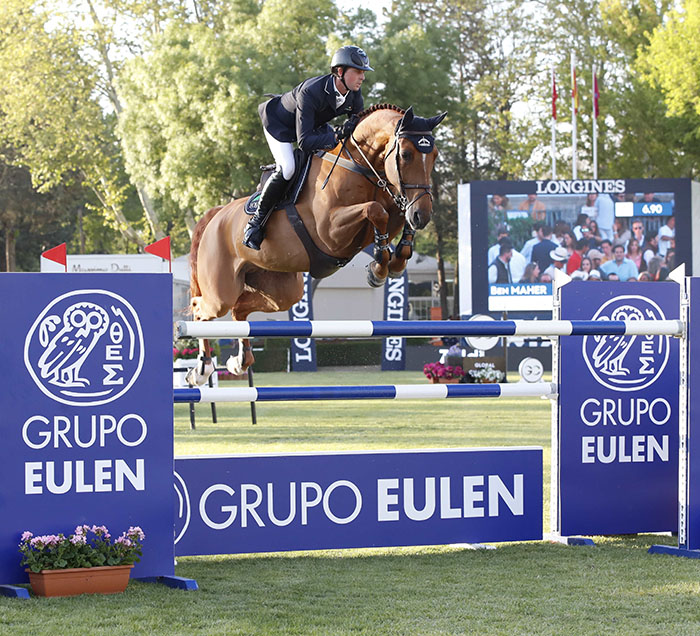
Explosion explodes…
The gelding really did explode onto the international scene, he was jumping 1.45 classes at the beginning of the year, and had his first 1.60 start in Shanghai in April, for a win and €47,850! Currently ranked 5th.
Chacco-Bue has eight offspring in the top 100 world rankings, aside from Explosion, there’s Chacna (Narew xx) 34th, Chacco Kid (Come On) 49th, Chapilot (Pilot) 58th,Chacanno (Kannan) 60th, Chalou (Baloubet du Rouet) 61st, Blue Movie (Pilot) 63rd and Miss Untouchable (Aldatus) 64th.
It is somewhat amazing that Chacco-Blue, born in 1998, with his career cut short when he died in 2012 should amass so many more points – 31,387 to 19,405 – than the French great, Diamant de Sémilly, who was born in 1991, and whose semen is still being offered – fresh even – from the Haras de Couvains in the 2018 season!
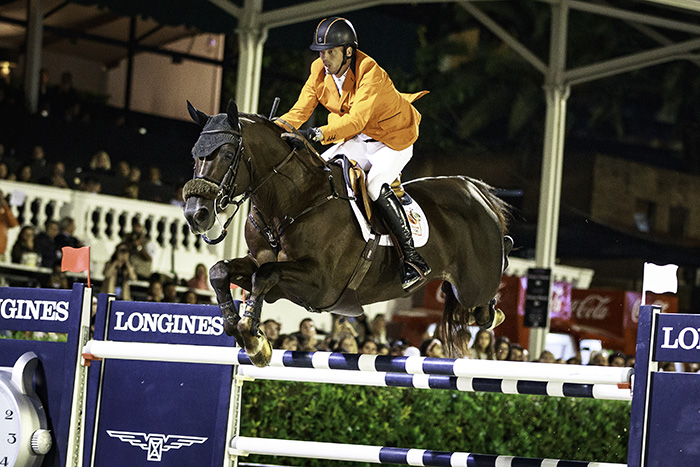
Harrie Smolders and Don VHP Z NOP (photo FEI/Libby Law)
Diamant de Sémilly has just one horse in the top 100 rankings, the very successful Don VHP Z NOP (Voltaire) comes in at 46th. The stallion has career earnings of €1,459,753 with Harrie Smolders. The next most successful is Inca Boy van t’Vianahof (Cash), ranked 119, whose best result so far was a third in the 5* Grand Prix at Rome, with Edwina Tops Alexander, more recently he has been mainly competing in the 1.35 / 1.45 classes. So far he has earned €162,916.
There is only one surprise in the other 28 stallions that make up the top 30: 3. Casall, 4. Cornet Obolensky, 5. Kashmir van’t Schuttershof, 6. Berlin, 7. Toulon, 8. Cardento, 9. Balou du Rouet, 10. Nabab de Rêve, 11. For Pleasure, 12. Kannan, 13. Tangelo van de Zuuthoeve, 14. Clinton, 15. Quidam de Revel, 16. Verdi, 17. Lord Z, 18. Calvaro, 19. Contendro I, 20. Numero Uno, 21. Cicero Z van Paemel, 22. Baloubet du Rouet, 23. Indoctro, 24. Colman, 25. Mylord Carthago, 26. Heartbreaker, 27. Thunder van de Zuuthoeve, 28. Quasimodo Z, 29. Cassini I, 30. Vigo d’Arsouilles.
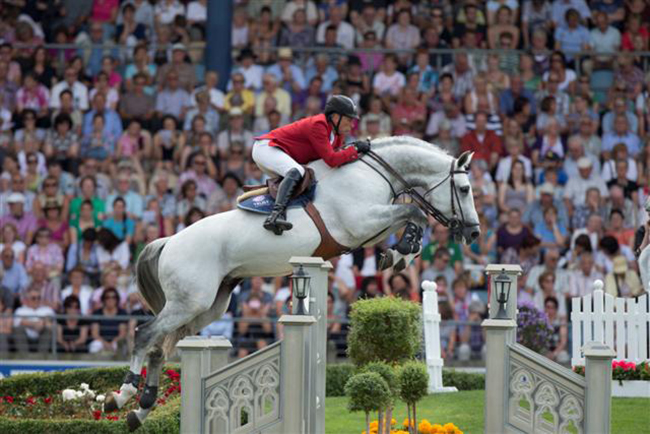
Cicero Z van Paemel sire of 33 jumpers at 1.60 level…
Cicero Z van Paemel did I hear you splutter? Unlike all the others, this is not exactly a household name. The stallion had a moderate international jumping career with Dirk Demeersman from 2008 until it was ended after surgery in 2013, winning €18,635, with their biggest payout €5875 for first in a 1.50 class at Antwerp.
He is by the great Carthago and out of a mare by Randel Z – from a mare line that has produced many jumpers. Randel Z is the classic Zangersheide cocktail: Ramiro, Almé, Gotthard, he was a modestly successful sire, producing three 1.60 jumpers, none of them stars.
Cicero is the sire of an impressive 33 metre sixty jumpers, and another 13 that have gone 1.55. His major points scorer is the 130th placed, Jewel de Kwakenbeek, who is out of a Quidam de Revel mare with another cross of Ramiro on his mare line. So far, Jewel has amassed €101,034 with his best payout, €6250 for winning a 1.45/1.50 class at Lier.
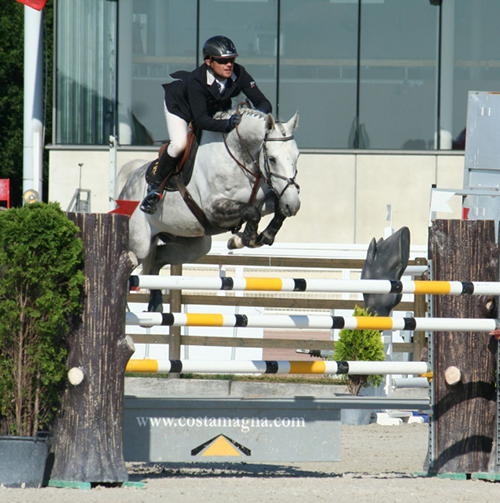
Jewel de Kwakenbeek (photo credit – L’equimag.be)
Even though those to 20 contain no surprises, the figures show some significant changes to the top 10: mega-stars For Pleasure (Furioso II – Gigantin x Grannus), Kannan (Voltaire – Cemeta x Nimmerdor) and Baloubet du Rouet (Galoubet A – Mesange du Rouet x Starter) are all out; Baloubet even plummets out of the top 20!!
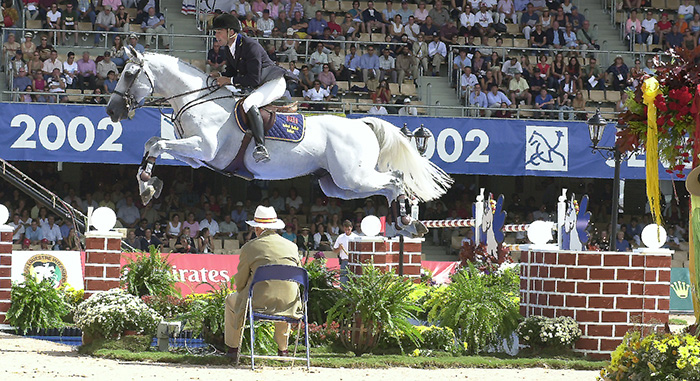
Cardento competing at the 2002 WEG in Jerez
New entrants to the top 10 are: Cardento (Capitol I – B-Estelle x Lord), Toulon (Heartbreaker – Nikita x Jokinal de Bornival) and Nabab de Reve (Quidam de Revel – Melodie en Fa x Artichaut). This is something of a comeback for Cardento and Nabab: Cardento also featured in the top 10 in 2014 and 2016, while Nabab has been top-10 in 2008, 2009, 2010 and 2012! Nabab also gets an honorable mention for sharing the top-10 with his son Toulon.
The stallions with the greatest paternal influence on the top 10 are Caretino (Caletto II – Isidor x Metellus) with one son – Casall (Caretino – Kira XVII x Lavall I) and one grandson – Berlin (Cassini I – Estia x Caretino), and Heartbreaker (Nimmerdor – Bacarole x Silvano) is also represented by one son – Toulon, and one grandson – Cornet Obolensky (Clinton – Rabanna van Costersveld x Heartbreaker).
There has been a lot of discussion recently about just how much ‘blood’ is needed in the modern showjumper; looking at the 2018 top 20, the average amount of blood seen in these stallions is just under half: 48.03%. So does that mean that most of these stallions are half Thoroughbred?? Absolutely not. This high blood percentage in jumping horses is generally maintained by crossing high-blood horses together.
Of the top 10 stallions, none had a Thoroughbred appearing in the pedigree earlier than the 3rd generation (sire and dam being generation 1). When we consider the entire top 20, there are three stallions that have Thoroughbred in the 2nd generation ie grandsire and/or granddam: For Pleasure, who has 32.23% blood, Tangelo van de Zuuthoeve (Narcos II – Olympia van de Krekebeke x Laudanum xx) who has 58.20% blood, and Lord Z (Lord – Thia x Calando I) who has 64.45% blood.
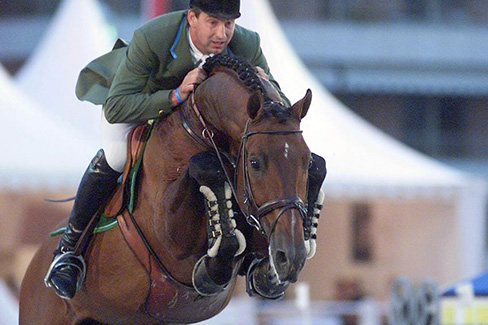
Lord Z, 64.45% blood
The stallions with the highest blood percentages in the top 20 are: Lord Z at 64.45%, Quidam de Revel (Jalisco B – Dirka x Nankin) at 63.28%, and Nabab de Reve at 60.55%. Interestingly, despite Nabab’s high blood percentage, a Thoroughbred ancestor is not seen in his pedigree until the 4th generation.
The most common position for the first Thoroughbred ancestor to be found in the pedigree of this top 20 is in the 3rd generation (45% of top-20 stallions) followed by the 4th generation (40% of top-20 stallions).
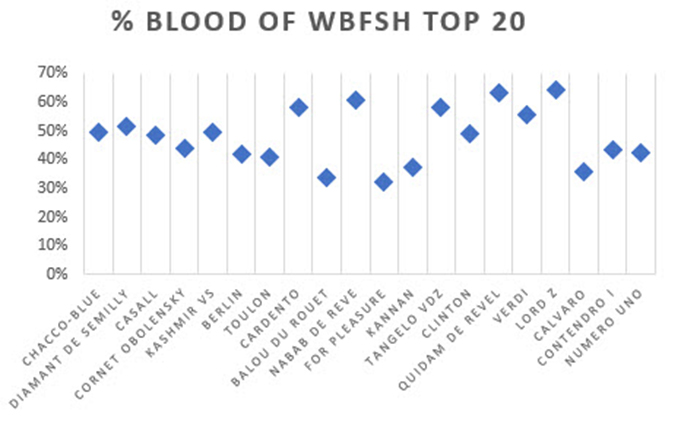
Another interesting statistic from the 2018 top 20 jumping sires is that ALL of these stallions have some degree of line-breeding in their first six generations. The closest that line-breeding appears in these pedigrees is in the 3rd generation, with 30% of these top-20 stallions being line-bred this close. A staggering 60% of these stallions see their first line-breeding appear in generation four, while 10% appear in generation five.
These findings are fairly consistent with Federico Tesio’s famous theory concerning line-breeding, whereby he recommends that it is most successful when used in the ‘engine room’, otherwise known as generations four through to six.
The most heavily line-bred stallion in the top 20 is Contendro I (Contender – Bravo x Reichsgraf). Contendro I is line-bred to Ramiro (Raimond – Valine x Cottage Son xx) 3x4x4, with him appearing in both the top and bottom of the pedigree, and through both male and female offspring (ie sex-balanced). The Anglo-Arab, Ramzes X (Rittersporn xx – Jordi x Shagya X-3) appears 5x5x5x6x6, again top and bottom and sex-balanced. We also see the great Thoroughbred Ladykiller xx (Sailing Light – Lone Beech x Loaningdale) and the Holsteiner Heintze (Heinx – Omlette x Wildfang) appear in the pedigree, both at 5×6.
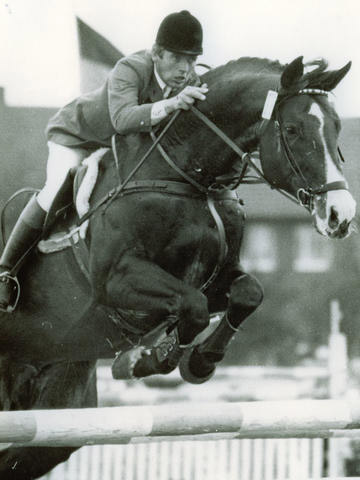
Ramiro appears Contendro’s pedigree 3x4x4 top and bottom
And finally, our own version of the top 20 by ‘strike rate’. For this exercise we used the information from Horsetelex. While this information is by no mean infallible, it does provide a standardized means of comparison of these stallions. It is based on strike-rate of offspring that have reached the 1.60m level out of the total number of progeny by that stallion that appear on the Horsetelex pedigrees.
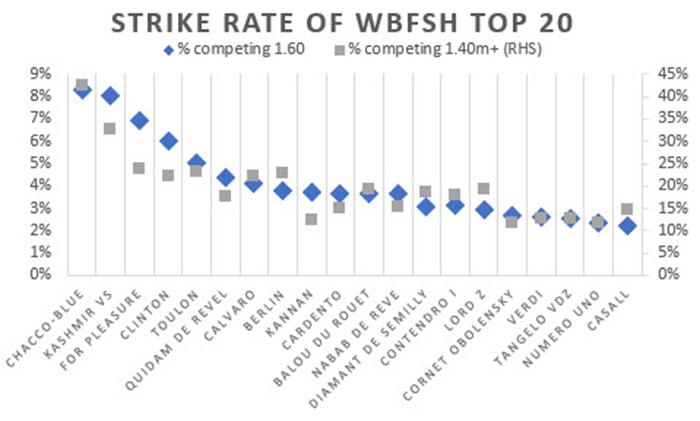
1. Chacco-Blue (8.29%) 2. Kashmir van’t Schuttershof (Nabab de Reve – Fines van Kameren x Tenor Manciais) (8.07%) 3. For Pleasure (6.94%) 4. Clinton (Corrado I – Urte x Masetto) (6.01%) 5. Toulon (5.03%).
Chacco-Blue also had the highest strike-rate of the top 20 when it came to offspring competing at 1.40m level and above, at 42.39%. So yes, over 40 PERCENT of offspring by Chacco-Blue, as recorded in the Horsetelex database, have competed to a level of 1.40m and above. Just, wow.
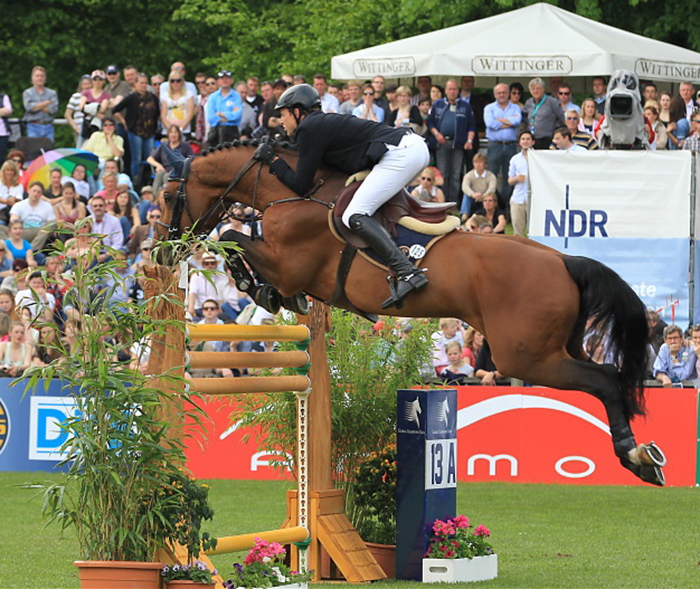
Chacco-Blue and Andreas Kreuzer in the Grand Prix of Hamburg 2012
– they were 10th in a super field (Sportfot/GCT)
The Chacco-Blue bloodline is available in Australia from IHB – Stallions like Chacoon Blue, but there’s more: www.ihb.com.au
